Introduction to Psilocybin – Effects of Psilocybin – History of Psilocybin
Chemistry of Psilocybin
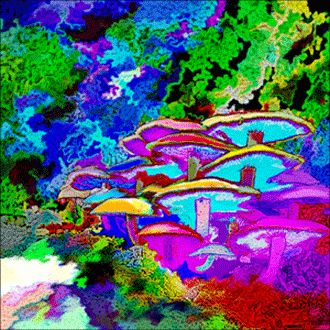
From a clinical standpoint there are few signs that come along with the effects of psilocybin of the body other than irregular and unusual behavior.
· Most physical effects appear to be due to the stimulation of the nervous system while the motor skills decrease in efficiency.
· Increased heart rate appears in less than half of those examined while under the effects of psilocybin.
· Dilated pupils are present in over ninety percent of those examined. Along with this comes enhancement of the deep tendon reflexes found in more than half of those observed.
The hallucinations are very variable depending on the user’s mindset and the dose of the drug ingested The following is an outline of factors that influence the effects of psilocyibin:
· The circumstances under which the mushrooms are used, (e.g. At home, in a group, alone, or as part of a ritual or ceremony)
· The physiological makeup of the individual, including his or her cultural heritage
· Previous experiences with mushrooms and the current expectations
· Dose
· Method of preparation of the fungi (Benjamin, 1995, p. 330)
There are many variables that come into play during a “trip” that determine the overall experience.
Timeline for Psilocybin and its Effects
· 0-30 minutes: Anxiety and tension develop; there may be light-headedness, mild abdominal pain, nausea, weakness, shivering, and muscle aches. The lips may feel numb.
· 30-60 minutes: Onset of visual effects and distortion, development of euphoria and an introspective state; increases in auditory acuity, sweating, tearing, and facial flushing; inability to concentrate; depersonalization; incoordination; tremulous speech; feeling of unreality.
· 1-2 hours: Visual effects intensify, greater distortion of perception; alteration of time sense; continued euphoria, rumination and introspection.
· 2-4 hours: gradual reduction of symptoms, with complete resolution in the majority of individuals. The subject is generally completely normal after 4-8 hours. A few people will have headaches or fatigue, and some experience a more subtle sense of well-being for a number of days.
The duration of the effects of an average dose of psilocybin mushrooms used for “recreational” purposes usually ranges from four to five hours. Headache and hangover are quite uncommon. A feeling of peace and serenity for a number of days after also is not uncommon. In a few subject the flashback has been described, and can continue sporadically in very short spurts, for a number of months. Deaths and dependency directly related to psilocybin rarely occur
[Read more →]
Categories: Psilocybin
Introduction to Psilocybin – Effects of Psilocybin – History of Psilocybin
Chemistry of Psilocybin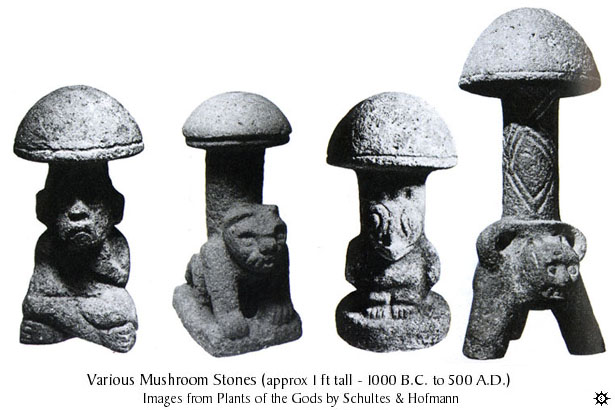
Hallucinogenic mushrooms containing psilocybin have probably existed longer than the human race. Throughout history, ancient pictures, carving, and statues have been seen, showing the importance of these fungi to ancient tribes. In Central and South America, use of psilocybin mushrooms was common religious practice until the arrival of Spanish settlers, who were intent on spreading the Catholic faith, strictly prohibited their use. For Indians the fungi are known as sacred mushroom and historically, it is considered entheogen, propelling them on a religious path to the spirit world.
-
Mushroom art and sculptures that depicted motifs under the cap of a mushroom were found in times as early as 1000-500 BC.
-
The purpose of these sculptures and artifacts was not certain, but it is speculated that the stones had religious meaning
-
In sixteenth century Europe alcohol was widely known and used, and even though used symbolically in religious service, served no real purpose in religion.
-
During the Spanish conquest of Central America stories began to come back telling of the use of inebriants in religion.
-
Three substances were mention, one of which was a sacred mushroom called teonanacatl, as well as peyote and the morning glory flower
-
The Codex Vienna Mixtec manuscript that dated back to thirteen century depicted the ritual use of the sacred mushrooms by the Mixtec Gods.
-
The God known as Seven Flowers was the Mixtec God of hallucination, especially in regards to mushrooms, and he was often depicted carrying a pair of mushrooms in his hands
-
Sadly with the conquest of Central America and the integration of Catholicism into the culture these mushrooms were nearly all but lost (Lincoff & Mitchell, 1977).
At the beginning of the twentieth century interest in hallucinogenic plants reappeared.
- The first hallucinogen to be confirmed as such was the peyote cactus.
- At first there was little evidence that morning glory or mushrooms were hallucinogenic, and it was assumed that peyote could be attributed as the reason for all early accounts.
- Just prior to World War II it was found that extracts of the morning glory seed had a depressive effect on the nervous system and ethnobotanists Schultes and Reko discovered these seeds were still in use by local “doctors” in Mexico.
- They traveled to Mexico and sought out these mushrooms and Schultes published a report of his findings in Harvard University Botanical Museum Leaflets in 1939.
This is when and why the use of hallucinogenic fungi was rediscovered
-
After hearing of Schultes and Reko and their finding the hallucinogenic mushrooms in Mexico the ethnomycologists Wasson and Heim went to Central America to investigate the use and effects of these “magic mushrooms”.
-
They published their findings in Life magazine in 1957 their use of the term “magic mushroom” made the term a household name.
-
These mushrooms became a symbol of counterculture in the late 1960’s and 19670’s and became widely used in the United States and Britain. There are no other types of mushrooms that are capable of reflecting the society, culture, and its values the way these mushrooms did at that time. These psilocybin mushrooms lead to the discovery of LSD, a man made chemical hallucinogenic.
-
Today there is still fairly high usage of the drug, and a recent Danish study reported that about 7% of all students have had an experience with psilocybin mushrooms.
-
In another study of drug abusing teenagers, 26% reported using “magic” mushrooms
-
Psilocybin mushrooms are now a Schedule I illicit substance in America, under the Controlled Substances Act, making it completely illegal 
[Read more →]
Categories: Psilocybin
Introduction to Psilocybin – Effects of Psilocybin – History of Psilocybin
Chemistry of Psilocybin
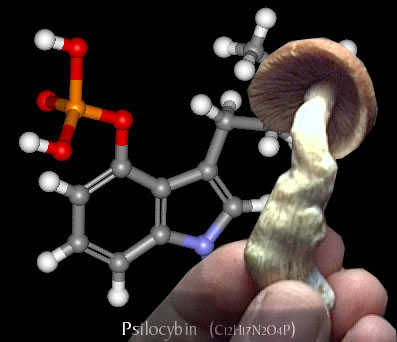
Not long after the initial discovery of magic mushrooms and their effects, that these hallucinogenic fungi before the chemistry involved with these experiences and the drug was examined under a microscope.
· The main type, Psilocybe genus, of mushrooms was found to contain the active ingredients of psilocybin and psilocin.
· After examination a variety of four and five hydroxylated N-methyeltryptamines were isolated from the mushrooms.
· The two compounds, psilocybin and psilocin, are equally psychoactive. Colorless psilocybin can be rapidly oxidized to reveal a blue colored product, which is one of its most common field identification features.
Molecules
· One molecule of psilocybin (O-phosphoryl-4-hydroxy-N) can be broken down into one molecule of psilocin (4-hydroxy-N, N-dimethyl-tryptamine).
· Psilocybin is quickly dephosphorylated to its phosphate ester, psilocin, by alkaline phosphatase, an enzyme present both in the brush border of the intestines and in the liver.
· This removes the phosphate group from psilocybin then leaving, psilocin to be passed along through the bloodstream.
· This breakdown occurs when the mushroom is orally ingested In the Body
· Within thirty minutes the toxins from the drug will have equilibrated, although it accumulates in the liver and adrenal glands.
· This accumulation in the liver and adrenal glands continues for up forty right hours, which could be a very good explanation for the prolonged euphoric sensation that is experienced by many after an ingestion of mushrooms.
· It is interesting that monoamine oxidase, the enzyme normally responsible for the metabolism and degradation of other biogenic amines, such as serotonin, plays almost no role in the elimination of psilocin.
· Usual tryptamine derivatives absorbed from the digestive tract, such as serotonin, do not normally cross the blood-brain barrier. · Psilocin is believed to cross into the brain, most likely due to its high lipid solubility and monoamine oxidase’s failure to affect it
· Structural similarities to the biogenic amines responsible for neurotransmission, such as dopamine and serotonin, suggest that the effects of psilocin are passed through the same pathways, perhaps by “antagonizing” serotonin
· It has also been considered that psilocybin and psilocin, “like other hallucinogenic drugs analogous to serotonin, have serotonin-like and anti-serotonin activities. Possibly their effects on the mind could be related to these actions.”
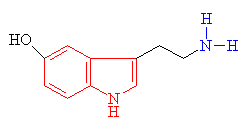

Serotonin
The indole ring is shown in red
and the amine group in blue |
Psilocin
The hydrolysed form of psilocybin
with the change shown in blue |
· As you can see above the two molecules both contain indole rings, which are a 6- membered benzene ring fused to a 5-membered ring containing nitrogen.
· The only difference is the addition of methyl groups. This makes the molecule more lipophilic, soluble in fats, in turn, better able to penetrate the fatty membranes that protect nerves and nerve endings.
· This allows the molecules to easily penetrate the central nervous system, making them more potent.
· Psilocybin has this indole ring, with a phosphoric acid group attached to it. In the body the phosphoric acid group is oxidized to the hydroxyl compound, psilocin, as previously discussed

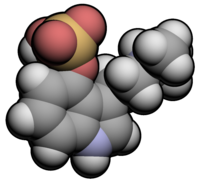
[Read more →]
Categories: Psilocybin
Introduction to Psilocybin – Effects of Psilocybin – History of Psilocybin
Chemistry of Psilocybin

· “Magic Mushrooms” have been part of human culture since the earliest recorded history.
· They have been utilized for many different purposes, ranging anywhere form spiritual enlightenment to recreational uses.
· “Alice” encountered it in her “Wonderland” as early as 1865. It had not been until more recent years that much has been know about the drug and its chemical properties.
· With the realization of this drug and its use becoming better studied it has been established that active component in magic mushrooms is a molecule called psilocybin.
· Psilocybin (along with another molecule, psilocin) are the compounds responsible for causing the hallucinations associated with the drug.
· Psilocybin is present in hundreds of species of fungi, most commonly in the Psilocybe genus.
· Magic mushrooms containing psilocybin have made clear and distinct impacts on society and have also been greatly affected by society and its view on the drug.
· Either way psilocybin has been a very important molecule in history.
[Read more →]
Categories: Psilocybin









